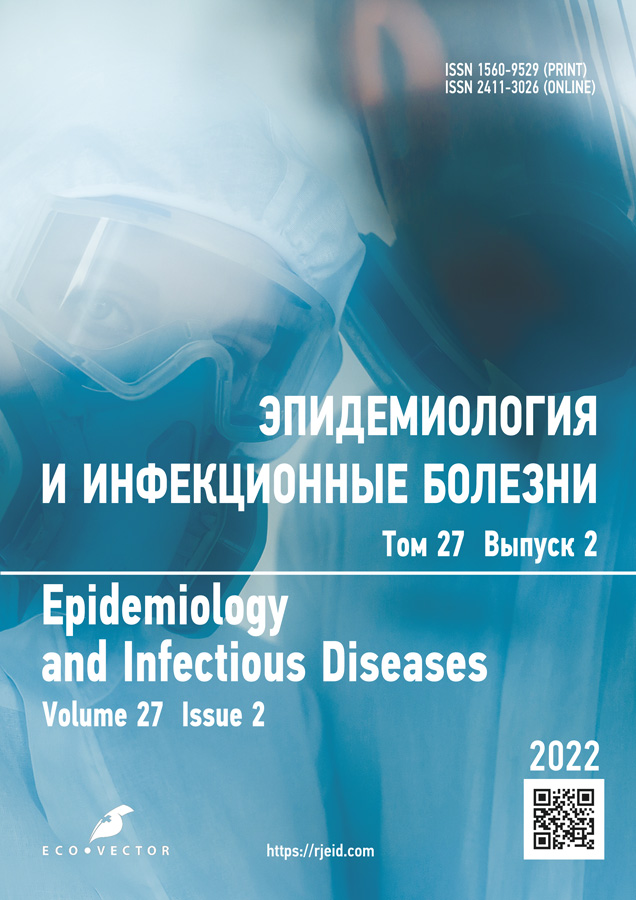Identification of additional ways to reduce the incidence of tuberculosis in patients with human immunodeficiency virus infection
- 作者: Frolova O.P.1,2, Sharkova T.I.2, Butylchenko O.V.1, Severova L.P.1, Abramchenko A.V.2
-
隶属关系:
- Institute of Clinical Medicine named N.V. Sklifosovsky, Sechenov First Moscow State Medical University (Sechenov University)
- Pirogov Russian National Research Medical University
- 期: 卷 27, 编号 2 (2022)
- 页面: 128-135
- 栏目: Original study articles
- ##submission.dateSubmitted##: 06.09.2022
- ##submission.dateAccepted##: 28.09.2022
- ##submission.datePublished##: 27.10.2022
- URL: https://rjeid.com/1560-9529/article/view/110796
- DOI: https://doi.org/10.17816/EID110796
- ID: 110796
如何引用文章
详细
BACKGROUND: According to official statistics from the Russian Federation in 2021, human immunodeficiency virus (HIV) infection was more often registered in the general population than in vulnerable groups.
AIMS: This study aimed to determine the characteristic patient cohorts with tuberculosis (TB) and HIV coinfection in dynamic epidemiological environments and propose additional organizational approaches to reduce TB incidence in patients with HIV.
MATERIALS AND METHODS: We investigated the complete medical data of patients with TB and HIV coinfection in three Russian regions. Additionally, we analyzed the cohort of patients with TB and HIV coinfection through sexual transmission. Furthermore, confidential interviews with patients with TB and HIV coinfection were undertaken. Specifically, reasons for refusing clinical examination at a Russian Federal AIDS Center (RFAIDSC) were clarified.
RESULTS: Among patients with TB and HIV coinfection, parenteral transmission remains the primary HIV infection route. Moreover, patients who acquired infection through sexual contact are also primarily socially disadvantaged, leading to the refusal of clinical examination and a consequent late detection of TB. On the contrary, patients who are unemployed report that they do not have the financial means to travel to the regional RFAIDSC. Widespread, rapidly progressive MDR TB infections more often occurred in patients with TB and HIV coinfection than in patients with TB but without HIV. Considering that every fourth patient with TB in Russia has been diagnosed with HIV. Moreover, there are specific features regarding the development and course of TB, and the generally accepted criteria for assessing the quality of TB without HIV care often become biased for patients with coinfection. This can lead to unreasonably negative assessments of the antituberculosis system and its work.
CONCLUSIONS: In view of the above, it is important to modify regulatory documents regarding informing patients about the importance of seeking timely medical help and solve the issue of travel for patients who are unemployed to medical examinations and in emergency cases. It is also important to introduce adjustments for the criteria in assessing the quality of TB care, thereby accounting for the pathogenesis of TB in patients with HIV coinfection.
全文:
作者简介
Olga Frolova
Institute of Clinical Medicine named N.V. Sklifosovsky, Sechenov First Moscow State Medical University (Sechenov University); Pirogov Russian National Research Medical University
Email: opfrolova@yandex.ru
ORCID iD: 0000-0002-2372-5341
SPIN 代码: 2681-9353
MD, Dr. Sci. (Med.), Professor
俄罗斯联邦, Moscow; MoscowTatiana Sharkova
Pirogov Russian National Research Medical University
Email: tisharkova@mail.ru
ORCID iD: 0000-0003-4224-6060
SPIN 代码: 7439-4520
MD, Cand. Sci. (Med), Associate Professor
俄罗斯联邦, MoscowOlga Butylchenko
Institute of Clinical Medicine named N.V. Sklifosovsky, Sechenov First Moscow State Medical University (Sechenov University)
Email: olga16.53@list.ru
ORCID iD: 0000-0001-9082-0624
SPIN 代码: 1841-7813
MD, Associate Professor
俄罗斯联邦, MoscowLyudmila Severova
Institute of Clinical Medicine named N.V. Sklifosovsky, Sechenov First Moscow State Medical University (Sechenov University)
Email: lyudmila.severova.1992@mail.ru
ORCID iD: 0000-0002-7488-5281
SPIN 代码: 1894-0820
俄罗斯联邦, 4, Bldg. 2, Dostoevskogo St., Moscow, 127473
Anna Abramchenko
Pirogov Russian National Research Medical University
编辑信件的主要联系方式.
Email: av.abramchenko@mail.ru
ORCID iD: 0000-0002-9621-9271
SPIN 代码: 7560-6306
俄罗斯联邦, Moscow
参考
- HIV infection in the Russian Federation as of December 31, 2021 [Internet]. Federal Scientific and Methodological Center for the Prevention and Control of AIDS. [cited 28 Sept. 2022]. Available from: http://www.hivrussia.info/wp-content/uploads/2022/03/Spravka-VICH-v-Rossii-na-31.12.2021-g..pdf. (In Russ).
- Frolova OP, Shinkareva IG, Kazennyi AB, Novoselova OA. Monitoring of tuberculosis associated with HIV infection. Problems of Tuberculosis in Patients with HIV Infection. 2010;(9): 12–22. (In Russ).
- HIV infection in the Russian Federation as of June 30, 2021 [Internet]. Federal Scientific and Methodological Center for the Prevention and Control of AIDS. [cited 28 Sept. 2022]. Available from: http://www.hivrussia.info/wp-content/uploads/2021/08/Spravka-VICH-v-Rossii-1-polugodie-2021-g..pdf. (In Russ).
- Batyrov FA, Zhukova GB, Frolova OP. The contingent of patients with tuberculosis, combined with HIV infection, in an anti-tuberculosis institution. Problems of Tuberculosis. 2003;(5):6–83. (In Russ).
- Shilova MV. Tuberculosis in population of Russian Federation. Medical Alphabet. 2019;1(15):7–18. (In Russ). doi: 10.33667/2078-5631-2019-1-15(390)-7-18
- Frolova OP, Schukina IV, Novoselova OA, et al. Approaches to improving tuberculosis care in HIV-infected patients and criteria for its evaluation. Bulletin of RSMU. 2016;(1):79–82. (In Russ). doi: 10.24075/brsmu.2016-01-13
- Vasilyeva IA, Testov VV, Sterlikov SA. Tuberculosis Situation in the Years of the COVID-19 Pandemic – 2020–2021. Tuberculosis and Lung Diseases. 2022;100(3):6–12. (In Russ). doi: 10.21292/2075-1230-2022-100-3-6-12
- Nechaeva OV. Tuberculosis in Russia [Internet]. TsNIIOIZ [cited 28 Sept. 2022]. Available from: https://mednet.ru/images/materials/CMT/tuberkulez-2019.pdf. (In Russ).
- Sterlikov SA, Nechaeva OB, Son IM, et al. Industry and economic indicators of TB work in 2019–2020. Analytical review of key indicators and statistical materials. Sterlikov SA, editor. Moscow: RIO TsNIIOIZ; 2021. 63 p. (In Russ).
- Perelman MI, editor. Phthisiology: national guidelines. Moscow: GEOTAR-Media; 2007. 505 p. (In Russ).
- Chebyshev IV, Vorobiev AA, Pak SG, editors. Transmissible infections and invasions Interdisciplinary textbook for medical students. Moscow: Meditsinskoye informatsionnoye agentstvo; 2005. 440 p. (In Russ).
补充文件






